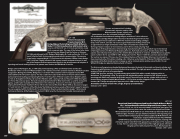Page 166 - 4094-BOOK2
P. 166
164
LOT 1167
Exceptional New York Engraved and Inscribed Smith & Wesson Model
No. 1 3rd Issue Revolver with Pearl Grips and Factory Letter - Serial
no. 115011, 22 RF cal., 3 3/16 inch solid rib bbl., nickel finish, pearl grips. The
accompanying factory letter states the revolver was shipped on October 1,
1875 and delivered to M.W. Robinson Co. of New York City with nickel finish and
rosewood grips. This was a 200 gun shipment. The floral scroll engraving, back
strap inscription and pearl grips were likely supplied by M.W. Robinson. The
back strap is engraved with the name “W.E. ATWATER.”
CONDITION: Exceptionally fine as period New York engraved, retaining 90%
untouched original nickel finish with gray patina on the balance. The engraving
is crisp. There is a small chip on the bottom of the right grip panel, otherwise
the grips are fine with attractive fiery colors. Mechanically fine.
Estimate: 1,500 - 2,500
LOT 1166
Historic Documented
Firearms Inventor W.C.
Dodge Shipped Factory Engraved Smith & Wesson
Model 1 1/2 First Issue Revolver with Factory Letter -
Serial no. 23769, 32 RF cal., 3 1/2 inch solid rib bbl., nickel
finish, rosewood grips. The copy of the factory letter states
the revolver was shipped from the factory on February
25, 1869 and delivered to W.C. Dodge of Washington, D.C. and confirms the 3 1/2 inch
barrel, full plate finish, factory engraving, and smooth rosewood grips. This was one
of two factory engraved Model 1 ½ First Issues in this shipment. William Castle Dodge
(1827-1914) was a highly influential 19th century inventor and patent lawyer. He was
one of the foremost and least appreciated figures in the development and adoption of
repeating and breech loading firearms. His patents were used on the S&W Model 3 revolver.
Dodge came to Washington, D.C., in 1860 after previously being a ‘49er and frontier farmer and was the
doorkeeper of the U.S. House of Representatives. He is listed as one of the assistant marshals at Abraham Lincoln’s
inauguration. During the Civil War, Dodge was a U.S. Patent Office examiner until he resigned in early 1864
and established his own patent agency. The war is said to have spurred his interest in firearms advancements,
particularly breech loading and repeating firearms. He is the author of “Breech-Loaders versus Muzzle-Loaders;
or, How to Strengthen Our Army and Crush the Rebellion with a Saving of Life and Treasure” (1864) which gives
the Henry rifle particular praise. His book included advertisements for New Haven Arms Co. and his new patent
agency, and the latter included Oliver Winchester in his references. He was one of the men responsible for
helping Oliver Winchester modify the Henry rifle into the famous Winchester Model 1866 as discussed on pages
117 and 142-143 of “Evolution of the Winchester” by McDowell and also served as Winchester’s lawyer for patents.
He was recognized within his lifetime for his contribution to firearms and ammunition designs. “Historical and
Commercial Sketches of Washington and Environs” (1884) notes that he invented “valuable improvements in
firearms and ammunition” including
the automatic extractor used by Smith
& Wesson and in Europe, “eight or nine
improvements upon the celebrated Remington military
rifle and double-barreled breech-loading shotgun, and others.” It also references
his innovative cartridge filling machine that was ordered by the government after
the Washington Arsenal explosion in 1864. This machine made loading cartridges
faster, more uniform, and safer. He received a gold medal from the King of Italy and
an appointment as Knight Commander of the Order of Isabella the Catholic from
the King of Spain in relation to his inventions, and his firm is noted as having “had
entire charge of the patent business of several large manufacturing firms, among which may be mentioned
E. Remington & Sons, the Winchester Repeating Arms Co., Hall’s Safe and Lock Co., besides many others.” His
patents were influential in the genesis of the Smith & Wesson Model No. 3 revolvers. Smith & Wesson bought his
patent numbers 45,912 and 45,983 in 1869. Dodge also held U.S. Patent 114,653 for automatic ejection when
the revolver was opened. This was one of the standout features of the First Model American. He is known to
have presented some of the latter, including a No. 3 American and a Model No. 3 Russian Third Model revolvers
previously sold by Rock Island Auction Company as well as a Volcanic pistol-carbine owned by him. His son
William W. Dodge also patented improvements in firearms.
The factory scroll engraving on beaded background decorates the barrel at the muzzle and breech, cylinder, and
frame along with flourishes of scrolls on the back strap and butt. The right grip panel is numbered to the gun. The
revolver is fitted with a set of rosewood grips.
CONDITION: Very fine, retaining 70% untouched original nickel finish with a smooth dark gray patina on
the balance. The engraving is crisp. The grips are fine with handling marks and much of the original varnish
remaining with flakes and scattered dings visible overall. The action cycles, but the cylinder does not lock. A
historic factory engraved Smith & Wesson Model 1 1/2 First Issue revolver shipped to 19th century firearms
inventory W.C. Dodge who played an important role in S&W revolver design.
Provenance: Firearms inventor W.C. Dodge; Property of a Gentleman.
Estimate: 5,500 - 8,500


